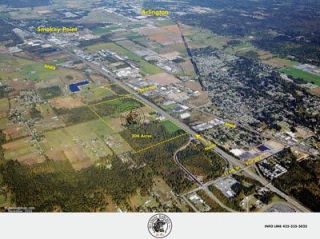TULALIP As Marysville licks its lips over prospects for landing a new University of Washington branch campus, owners of more than 200 acres on the Tulalip Indian Reservation say their proposal to host the college is valid and tenable.
Woody McCloud is a partner with the Marysville family that owns the MacAngus Ranch south of 136th Street NE on the west side of the freeway, where the family hopes to lure a new campus positioned to serve north Snohomish, Island and Skagit counties. He took exception to comments from Marysville Mayor Dennis Kendall, who said the ranch couldnt host the university because it lacked utility connections.
McCloud said the ranch is only 200 feet away from water hook-ups and the owners havent needed to connect to utilities from either the Tulalip Tribes or the city of Marysville. They havent asked during the 30 years they have owned the land, he added.
He said Kendall isnt the one who will make the decision, the state legislature and governor are and the state can make anything happen if it wants to. The MacAngus Ranch is outside the Marysville Urban Growth Area, but so is one of Marysvilles own proposals and several other private bids. The state of Washingtons requirements include a site inside or adjacent to a UGA, and McCloud said the ranch fits the bill, no matter how close utilities are.
They are going to make it happen no matter what piece of property is chosen McCloud said. We just think the political stuff is starting to fly. [Lets] judge a piece of property by its attributes.
McCloud said the ranchs eastern 100 acres would be a perfect location for a campus since it is right at the 136th Street bridge crossing over I-5 and only 200 feet away from the Burlington Northern Sante Fe railroad line. Under the Tulalip Tribal zoning the land is classified for commercial use, under Snohomish County it was zoned for agricultural use until an appellate court ruling recently nudged the County Council to remove the agricultural classification. Zoning laws do not typically include uses for schools, which have to get conditional use permits; but the state could possibly claim sovereignty when choosing a site, nullifying those issues. McCloud likens the potential campus to Boeing; if the aerospace giant needed something the state would make it happen.
We just feel that since we are on I-5, what a great location, McCloud said. Were looking forward to going through the process. We want to let the land speak for itself.
Marysville has two sites it is officially offering that made the first cut of nine sites. Two sites in Everett and one near Smokey Point in Arlington also made the short list, all others are in or near Marysville. The city is working with owners of properties about a mile north of the MacAngus Ranch, also on the west side of the freeway in the Lakewood neighborhood. Those two sites are on both sides of the railroad tracks, a selling point because they could potentially host a rail transit station, making it easier for students who might commute to classes.
But all of the owners of one site between the freeway and the railroad arent entirely onboard with the citys plan for the swath of land north of 156th Street NE; in fact, one was surprised to learn from a reporter that Marysville had nominated his commercial plot on Twin Lakes Avenue but went to great lengths to hide his chagrin. The city is also working with owners of a much larger plot west of the tracks at the same milepost that offers up to 300 acres. That site is also outside of the city UGA. Urban Growth Areas are a footprint mandated by state law delimiting future growth boundaries for cities and counties. It is illegal for those agencies to extend utility connections past those boundaries in most cases.
The state had 73 properties offered by many municipal and private owners, and the initial cut of nine could grow. Those sites that did not meet all of the states requirements can be considered if the owners follow up with more information or changes that do meet the requirements and new proposals are welcome, according to Martin Hegge, an architect leading the site selection process.
Reservation ranch landowner refutes city claims about proposed UW site
TULALIP As Marysville licks its lips over prospects for landing a new University of Washington branch campus, owners of more than 200 acres on the Tulalip Indian Reservation say their proposal to host the college is valid and tenable.



